Archive
Scsi Mirror “SyQuest” 44Mb + Removable disk cartridge
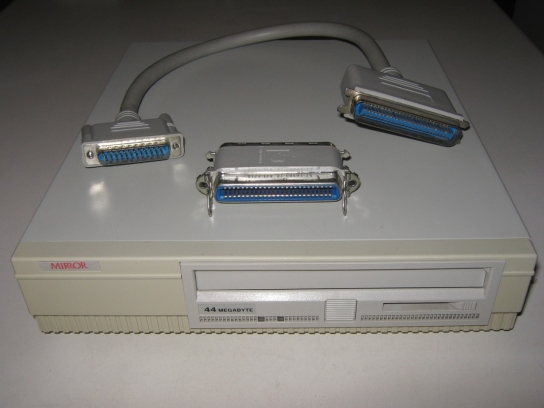
Autopsy:
Many thanks to a friend for the Apple SCSI terminator.
Hints: Macintosh Plus can boot from Cartridges.
from Wikipedia:
SyQuest Technology, Inc., now known as SYQT, Inc., was an early entrant into the removable hard disk market for personal computers. The company was started in 1982 by Syed Iftikar; it was named partially after himself because of a company meeting wherein it was decided that “SyQuest” ought to be a shortened name for “Sy’s Quest”.
Its earliest products were 3.9″ (100mm) removable hard drives, and 3.9″ (100mm) ruggedized hard drives for IBM XT compatibles and military applications. Some of their early fixed drives appear to be rebranded Seagate drives, especially when one compares the drive lists on this data recovery site with this product table. For many years SyQuest held the market, particularly as a method of transferring large desktop publisher documents to printers.
SyQuest aim their products to give personal computer users “endless” hard drive space for data-intensive applications like desktop publishing, Internet information management, pre-press, multimedia, audio, video, digital photography, fast backup, data exchange, archiving, confidential data security and easy portability for the road.
source: wikipedia
Coleco Vision Expansion Module #2
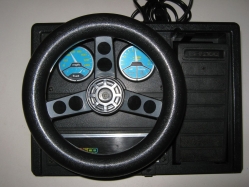
Autopsy:
from Wikipedia:
The Expansion Module #2 is a driving controller expansion that consists of a steering wheel, gas pedal and the pack-in game Turbo. The driving controller is also compatible with the games Destructor and Dukes Of Hazzard.
source: wikipedia
Texas Instruments (Clementoni) Dotto Conta-Parla
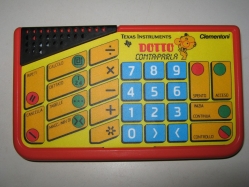
Autopsy:
from Wikipedia:
The Speak & Math was published in 1980 with a shape identical to both the Speak & Spell and the Speak & Read but with a completely different keyboard layout, different game features, and a different color scheme. Where the American Speak & Spell had been colored red with yellow and orange accents, the American Speak & Math was gray with blue and orange highlights. The Speak & Math was designed to focus on mathematics in children of ages 6–12 with a library of over 100,000 random and preprogrammed problems.
It was regarded as the spiritual successor to TI’s earlier DataMan series[81], with the difference mainly relating to the addition of speech synthesizing software and the visual display. The Speak & Math was only released to American and British markets.
In 1982, a compact version of the Speak & Math was developed contemporaneously with the Speak & Spell Compact. This version was only released in French as Les Maths Magique (lit. The Magical Math). A redesigned version was developed in 1985 for British markets under the name of Maths marvel. This was later released in Italian as Dotto Conta-Parla, in French as le Calcul magique (lit. Magical Calculator), and in German as Mathe-Fix.
The Speak & Math was very minutely redesigned in 1986, under the same name, with the new version representing nothing more substantial than a redesign of the faceplate graphics. In 1990 the Super Speak & Math was released as a major redesign similar to the first version of the Super Speak & Spell. As with the Super Speak & Spell, the display screen of the Super Speak & Math was changed to an LCD screen instead of the former VFD screen.
The keyboard was also expanded and given more functions. The general structure of the console was also altered similarly to the Super Speak & Spell such that the handle which had come at the top of the screen in prior Speak & Math units was now found on the bottom of the toy and ergonomic features were added to the shape.
source: wikipedia
Macintosh Memory Expansion Kit (4Mb)
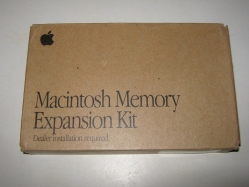
Autopsy:
Memory expansion boards add random access memory (RAM) to your computer system, often increasing the speed, storage, and power of your machine.
Some Coleco Vision Games Cartridges
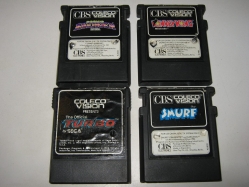
Cartridges list:
- Donkey Kong by Nintendo.
- Cosmic Avenger by Universal.
- The Official Turbo by Sega.
- Smurf by Peyo.
click here for the CBS Coleco Vision category.
Commodore 64 Datel EX64 Cartridge Expander
CBS ColecoVision Secam alternative RGB pinouts from ColecoVision.dk
 CBS ColecoVision RGB pinouts only for the French (Secam) AV Out version.
CBS ColecoVision RGB pinouts only for the French (Secam) AV Out version.
Here my first ColecoVision RGB hack.
source: colecovision.dk
My 80s year homebrew T-Shirt of Dracula Soft
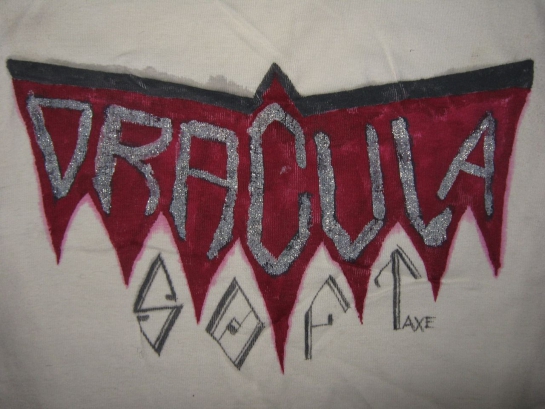
This is my old T-Shirt of “Dracula Soft” found and photographed. The “Dracula Soft“ logo is made by my brother.
Macintosh Plus 1mb
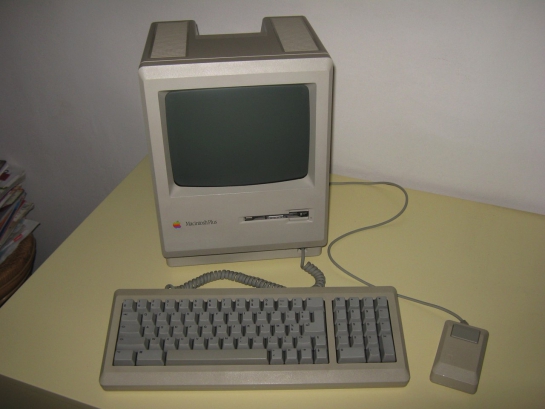
Autopsy:
from Wikipedia:
The Macintosh Plus computer was the third model in the Macintosh line, introduced on January 16, 1986, two years after the original Macintosh and a little more than a year after the Macintosh 512K, with a price tag of 2599 USD. As an evolutionary improvement over the 512K, it introduced RAM expansion from 1 MB to 4 MB, and the SCSI peripheral bus, among smaller improvements. It originally had the same generally beige-colored case as the original Macintosh (“Pantone 453″), but in 1987, the case color was changed to the long-lived, warm gray “Platinum” color.
 Introduced as the Macintosh Plus, it was the first Macintosh model to include a SCSI port, which launched the popularity of external SCSI devices for Macs, including hard disks, tape drives, CD-ROM drives, printers, and even monitors.
Introduced as the Macintosh Plus, it was the first Macintosh model to include a SCSI port, which launched the popularity of external SCSI devices for Macs, including hard disks, tape drives, CD-ROM drives, printers, and even monitors.
Its SCSI implementation was engineered shortly before the initial SCSI spec was finalized and, as such, is not 100% SCSI-compliant. As the Mac Plus had no provision at all for expansion other than the SCSI bus, the entire onus of expansion was on the user.
This usually made it very expensive. SCSI ports remained standard equipment for all Macs until the introduction of the iMac in 1998. The Macintosh Plus was the last classic Mac to have a phone cord-like port on the front of the unit for the keyboard, as well as the DE-9 connector for the mouse; later models would use ADB ports.
source: wikipedia
My old “Dracula Soft” Business Card from 80s year
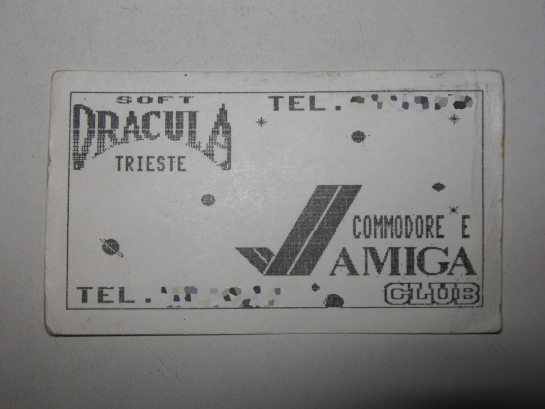
This is my old business card of “Dracula Soft” found and photographed.
I have taken the “Dracula” logo from the game: Bram Stoker’s Dracula.
Monitor Commodore 1084

Autopsy:
from C64-Wiki:
The Commodore 1084, which was originally developed for the Amiga, is a very good colour monitor for the Commodore 64. With its many ports it can be used for connecting to many home and personal computers and can also be connected to video recorders, picture record players and TV tuners.
The Commodore 1084 has a good, sharp picture with luscious colours. All the important settings can be changed over regulators art the front or the back. While the 1084 only plays mono, the modell Commodore 1084S can also play stereo. Due to its good price performance ratio the 1084 was (and still is) very popular.
Download: Commodore 1084 Service Manual (2231)
source: c64-wiki.com
Xilinx CPLD XC9536 replacement PLA for Commodore 64

Autopsy:
The PLA chip (906114-01) used in the Commodore C64 is a generic 82S100 gate array with custom programming.
Its logic functions were dumped and reverse engineered by the community and are available from a variety of sources. This PLA uses the Xilinx CPLD XC9536 to emulate perfectly the PLA of the Commodore 64.
Download: Xilinx CPLD XC9536 JED C64 PLA + Eagle (2291)
source: zonadepruebas.com
Some Coleco Vision Games Cartridges with Instructions
Cartridges list:
- BurgerTime by Data East U.S.A.
- Rocky Super Action Boxing by United Artists Corporation + Joystick Sticker.
- WarGames by United Artists Corporation + Joystick Sticker.
- Buck Rogers by The Dille Family Trust.
click here for the CBS Coleco Vision category.
Atari Paddle
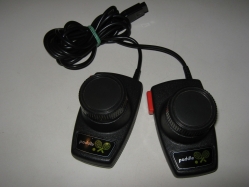
from Wikipedia:
A paddle is a game controller with a round wheel and one or more fire buttons, where the wheel is typically used to control movement of the player object along one axis of the video screen. A paddle controller rotates through a fixed arc (usually about 330 degrees); it has a stop at each end.
The paddle wheel is usually mechanically coupled to a potentiometer, so as to generate an output voltage level varying with the wheel’s angle relative to a fixed reference position. A paddle is thus an absolute position controller. That is, without any previous knowledge, the sensor can be read and the result directly indicates the position of the paddle knob. This is in contrast to a quadrature encoder-based device or “spinner”.
source: wikipedia
























































Recent Comments